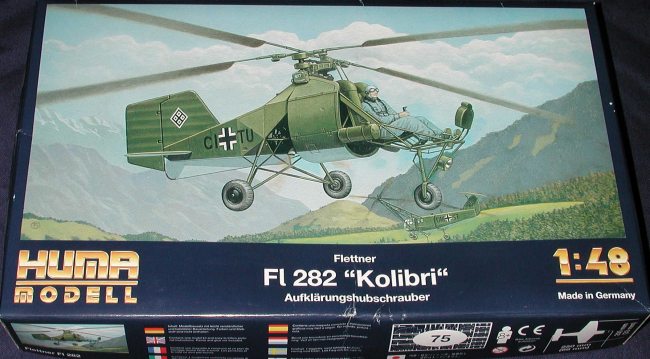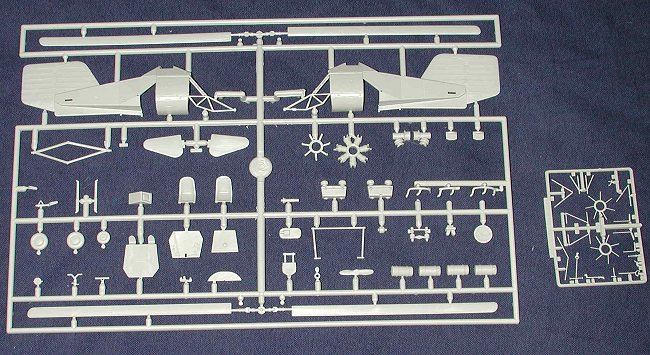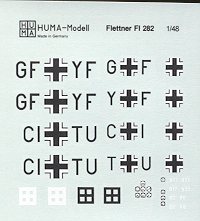
|
KIT: |
Huma 1/48 Flettner Fl-282 |
|
KIT # |
6500 |
|
PRICE: |
$29.98 |
|
DECALS: |
Two Aircraft |
|
REVIEW & |
|
|
NOTES: |

|
HISTORY |
Flettner was working on the problems of stability in helicopters and came up with the concept of intermeshing rotors; each turning in an opposite direction. This would overcome the problems of torque that caused yaw stability in earlier helo attempts. To allow yaw changes, his helicopters had conventional rudders and small tailplanes.
The previous helicopter, the Fl-265, was approved for production in 1940, but Flettner came up with an improved design capable of carrying a crew of two. Having room for an observer would make it an invaluable platform for gun spotting. A change in engine location from the nose to a central location gave the extra room needed. Tests with earlier helicopters determined that no defensive armament was needed as their excellent maneuverability made them nearly impossible targets to hit.
Substantial testing was done with the prototypes, including operating them from ships in the Baltic and Mediterranean starting in 1941. So successful were the 20 prototype and pre-production machines that a production order for 1,000 examples was made to BMW in 1944 as Flettner did not have the production capabilities needed. It was extensively used for convoy protection in the Med and Aegean, though there is little known of specific operations concerning the Fl-282 or any other German war-time helicopters.
|
THE KIT |

To my knowledge, this is the only 1/48 kit that Huma has produced and they couldn't have picked a more interesting subject. I do believe that it was chosen as it was small enough to fit into their injection molding machine! Unlike their rather fiddly 1/72 kit, this one appears to have been better engineered and should prove to be a more enjoyable kit to build.
Produced in Huma's greenish grey plastic, it has the kind of quality surface detailing that they have been known for. The detailing of the parts appears to be of a higher standard as well as they are not so rife with mold seams and some of the mis-alignment that the smaller kit suffered from. As Huma often does with its newer kits, there is a smaller sprue of very finely molded parts. Were this a Czech kit, those parts would be on an etched metal fret, however etched metal does not allow the proper three dimensional representation of parts like injected plastic or resin offers. The only option on this kit is to do a single or twin seater.
 The instructions are typical of Huma's later
releases. There several pictorial construction steps given which are easy enough
to follow. Because of all the open framework of this kit, one needs to pay extra
attention to getting things properly aligned and fit before adding the glue.
There are decals for two aircraft. One is an early prototype, the v6 in overall
RLM 63. The second is for the later v21 in RLM 71 over RLM 65. There is a color
three view of these aircraft given to help with decal placement. Interestingly,
this color change is different from that given in the 1/72 kit so some new
information must have come to light over the years between these two kits. The
decals themselves are quite matte, but after trimming off the excess carrier
film, have proven to work quite well. There is the usual 'block of squares' that
needs to be cut to produce the swastika. I'll grab one from the spares box!
The instructions are typical of Huma's later
releases. There several pictorial construction steps given which are easy enough
to follow. Because of all the open framework of this kit, one needs to pay extra
attention to getting things properly aligned and fit before adding the glue.
There are decals for two aircraft. One is an early prototype, the v6 in overall
RLM 63. The second is for the later v21 in RLM 71 over RLM 65. There is a color
three view of these aircraft given to help with decal placement. Interestingly,
this color change is different from that given in the 1/72 kit so some new
information must have come to light over the years between these two kits. The
decals themselves are quite matte, but after trimming off the excess carrier
film, have proven to work quite well. There is the usual 'block of squares' that
needs to be cut to produce the swastika. I'll grab one from the spares box!
It should be a really neat kit when done. I have seen it built up and was impressed with the result. If you want to read the build-up of the 1/72 kit, follow this link. If you want to read about the earlier Fl-265, follow this link.
Review kit courtesy of me and my wallet!
If you would like your product reviewed fairly and quickly by a site that averages over 2,500 visits a day, please contact me or see other details in the Note to Contributors.